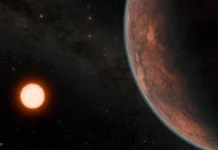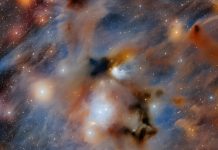
In 2021, a team of astronomers suggested that a recently discovered near-Earth asteroid, Kamo`oalewa, could be a chunk of the moon.
Two years later, another research group finds that a rare pathway could have enabled this to happen.
So far, only distant asteroids from beyond the orbit of Mars have been considered a source of near-Earth asteroids, says Renu Malhotra, professor of planetary sciences at the University of Arizona and a senior author of the paper in the journal Communications Earth & Environment.
“We are now establishing that the moon is a more likely source of Kamo`oalewa,” Malhotra says.
The implication is that many more lunar fragments remain to be discovered among the near-Earth asteroid population.
Researchers decided to study Kamo`oalewa for two reasons. Kamo`oalewa is uncommon in that it is Earth’s quasi-satellite, a term used for asteroids whose orbits are so Earth-like that they appear to orbit Earth even though they actually orbit the sun.
The other peculiar aspect of Kamo`oalewa is its longevity, says Jose Daniel Castro-Cisneros, the study’s lead author and a graduate student in the physics department. Kamo`oalewa is expected to remain as a companion of the Earth for millions of years, which is its remarkable feature, Castro-Cisneros says, unlike other known objects that stay in these very Earth-like orbits only for a few decades.
The 2021 study found that Kamo`oalewa’s spectrum was unlike that of other near-Earth asteroids but matched most closely that of the moon. Based on this, the team hypothesized that the asteroid could have been ejected from the lunar surface because of a meteoroidal impact.
In the new study, Malhotra and her team wanted to determine the feasibility of a knocked-off piece of the moon getting into this quasi-satellite orbit—a phenomenon that is quite unlikely, Malhotra says. Moon fragments that have enough kinetic energy to escape the Earth-moon system also have too much energy to land in the Earth-like orbits of quasi-satellites, she says.
With numerical simulations that accurately account for the gravitational forces of all the solar system’s planets, Malhotra’s group found that some lucky lunar fragments could actually find their way to such orbits. Kamo`oalewa could be one of those fragments created during an impact on the moon in the past few million years, according to the study.
Throughout its history, the moon has been bombarded by asteroids, which is evident in the numerous impact craters preserved on its surface, explains Malhotra. Impact craters are created when asteroids or meteorites crash into the surface of a planet or the moon. Impacts cause lunar material to be ejected from the moon’s surface, but most of that material usually falls back on the moon, she says.
Some of the ejected materials fall on Earth, and that’s how we get meteorites from the moon, Malhotra says. But a small fraction could escape the gravity of both the moon and the Earth and end up orbiting around the sun like other near-Earth asteroids. Numerical simulation suggests that Kamo`oalewa could be one of even tinier fractions that gained entry into the hard-to-reach Earth’s co-orbital space.
The study’s findings could help understand more about near-Earth asteroids, which are considered a hazard to Earth, Malhotra says. More detailed studies of Kamo`oalewa and determining this asteroid’s origin in a specific impact crater on the moon will provide useful insights on impact mechanics, she adds.
In the future, Castro-Cisneros says the team is planning to identify the specific conditions that allowed the orbital pathway of Kamo`oalewa. The group is also aiming to work on determining Kamo`oalewa’s exact age, he says.
“We looked at Kamo`oalewa’s spectrum only because it was in an unusual orbit,” Malhotra says. “If it had been a typical near-Earth asteroid, no one would have thought to find its spectrum and we wouldn’t have known Kamo`oalewa could be a lunar fragment.”
Follow us on Twitter for more articles about this topic.
Source: University of Arizona.



